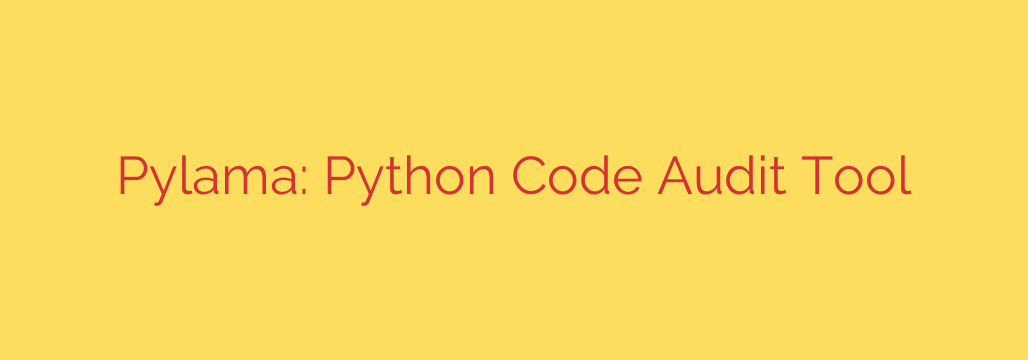
Pylama: The All-in-One Python Linter for Cleaner, More Reliable Code
Writing clean, maintainable, and error-free Python code is a top priority for any serious developer. While the Python ecosystem offers a wealth of powerful tools for code analysis—like PyLint, pycodestyle, and PyFlakes—managing them all can become a cumbersome task. Juggling multiple configuration files and command-line outputs often adds unnecessary complexity to your development workflow.
This is where Pylama comes in. Pylama is a comprehensive code audit tool for Python that acts as a wrapper around several popular linters. It provides a single, unified command and configuration to check your code against a wide range of standards, from style guides to potential bugs. By streamlining the code review process, Pylama helps you and your team enforce coding standards, improve code quality, and catch issues before they reach production.
What Makes Pylama an Essential Tool?
The primary advantage of Pylama is its simplicity and power of aggregation. Instead of running multiple linters separately, you run a single command. It intelligently gathers feedback from various tools and presents it in a clear, consolidated format.
Here are the key benefits of integrating Pylama into your workflow:
- Unified Interface: Say goodbye to memorizing different commands and flags for each linter. Pylama offers a single, easy-to-use command-line interface.
- Centralized Configuration: Manage all your linting rules from one file, such as
pylama.iniorsetup.cfg. You can specify which linters to run, which errors to ignore, and set path-specific rules without cluttering your project with multiple config files. - Comprehensive Code Audits: Pylama integrates a suite of best-in-class tools, ensuring your code is checked for a variety of issues, including:
- PEP 8 compliance (via pycodestyle)
- Common errors and unused imports/variables (via PyFlakes)
- Code complexity (via McCabe)
- Docstring conventions (via Pydocstyle)
- A wide range of potential bugs and code smells (via PyLint)
- Extensibility: Pylama is designed to be extensible, allowing you to easily add support for other linters or custom checks.
Getting Started with Pylama: A Practical Guide
Adopting Pylama is straightforward. Here’s how you can get it up and running in your project within minutes.
1. Installation
First, install Pylama using pip, Python’s package installer.
pip install pylama
This command installs Pylama and its essential dependencies.
2. Basic Usage
To run a check on your entire project, navigate to your project’s root directory and simply run the pylama command:
pylama your_project_directory/
Pylama will recursively scan all .py files in the specified directory and report any issues it finds, indicating the file, line number, and the error code.
3. Configuration for Your Project
For consistent results, especially within a team, creating a configuration file is highly recommended. Create a file named pylama.ini in your project’s root directory.
Here is an example configuration that selects specific linters, ignores a common “line too long” error, and skips certain directories:
[pylama]
linters = pycodestyle,pyflakes,mccabe
ignore = E501
skip = .venv/*,migrations/*
[pylama:pycodestyle]
max_line_length = 100
In this example:
- We explicitly choose to run
pycodestyle,pyflakes, andmccabe. - We globally ignore error
E501(line too long). - We tell Pylama to skip scanning the virtual environment and migrations folders.
- We also set a specific option for
pycodestyle, increasing the maximum line length to 100 characters.
This centralized configuration ensures that every developer on the team adheres to the same standards.
Best Practices for Effective Code Auditing
To get the most out of Pylama, consider these actionable security and maintenance tips:
Integrate with CI/CD Pipelines: The most powerful way to use Pylama is to automate it. Add a Pylama check as a step in your Continuous Integration (CI) pipeline (e.g., using GitHub Actions, GitLab CI, or Jenkins). Failing the build if the code doesn’t meet quality standards prevents bad code from ever being merged.
Use a Shared Configuration: Commit your
pylama.inifile to your version control system (like Git). This ensures that every developer uses the same rule set, leading to consistent code style across the entire project.Don’t Ignore Errors Blindly: While it’s sometimes necessary to ignore certain warnings, always understand why you are doing it. Many linting errors, especially from tools like PyFlakes and PyLint, can highlight subtle bugs or potential security vulnerabilities that are not immediately obvious.
Gradually Tighten Rules: If you’re introducing Pylama to a large, existing codebase, start with a lenient configuration. As you refactor and clean up the code, you can gradually remove ignored errors and enable more stringent checks.
Final Thoughts
In modern software development, code quality is not a luxury—it’s a necessity. Tools like Pylama are invaluable for maintaining a high standard of quality, readability, and maintainability. By consolidating multiple linters into a single, easy-to-manage tool, Pylama simplifies your workflow, strengthens team collaboration, and ultimately helps you build more robust and reliable Python applications. Make it a standard part of your development toolkit today.
Source: https://www.linuxlinks.com/pylama-code-audit-tool-python/








